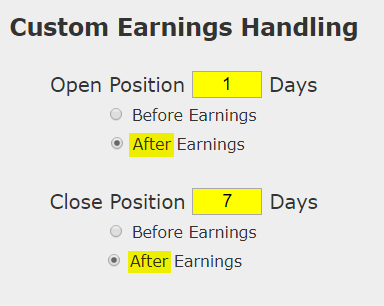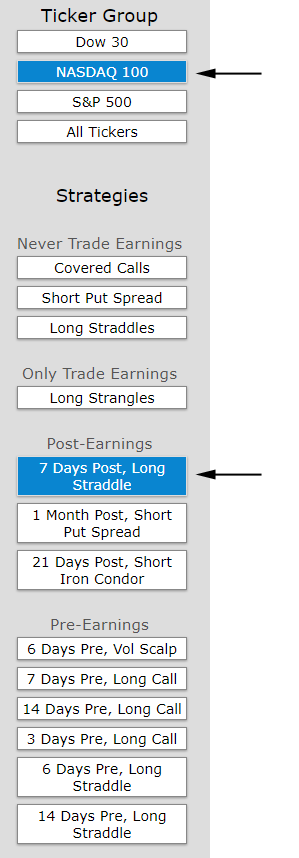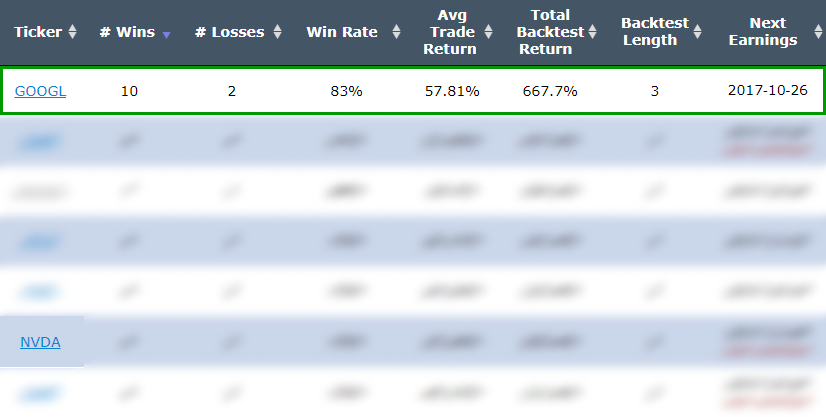Alphabet Inc, GOOGL, earnings, options, volatility, straddle

LEDE
We just penned an article that revealed Alphabet's pre-earnings momentum pattern -- that was a straight down the middle bullish momentum back-test with these results:
Tap Here to See the Back-test
Now we turn to a different pattern that starts right after earnings, takes no stock direction risk at all, but is equally compelling.
This is a slightly advanced option trade that bets on volatility for a period that starts one-day after Alphabet Inc (NASDAQ:GOOGL) earnings and lasts for the 6 calendar days to follow, that has been a winner for the last 3 years. We note the use of strict risk controls in this analysis.
Alphabet Inc (NASDAQ:GOOGL) Earnings
In Alphabet Inc, irrespective of whether the earnings move was large or small, if we waited one-day after earnings and then bought an one-week straddle (using weekly options), the results were quite strong. This trade opens one-day after earnings were announced to try to find a stock that moves a lot after the earnings announcement.
Simply owning options after earnings, blindly, is likely not a good trade, but hand-picking the times and the stocks to do it in can be useful. We can test this approach without bias with a custom option back-test. Here is the timing set-up around earnings:

Rules
* Open the long straddle one-calendar day after earnings.
* Close the straddle 7 calendar days after earnings.
* Use the options closest to 7 days from expiration (but at least 7-days).
This is a straight down the middle volatility bet -- this trade wins if the stock is volatile the week following earnings and it will stand to lose if the stock is not volatile. This is not a silver bullet -- it's a trade that needs to be carefully examined.
But, this is a stock direction neutral strategy, which is to say, it wins if the stock moves up or down -- it just has to move.
RISK CONTROL
Since blindly owning volatility can be a quick way to lose in the option market, we will apply a tight risk control to this analysis as well. We will add a 40% stop loss and a 40% limit gain.

In English, at the close of every trading day, if the straddle is up 40% from the price at the start of the trade, it gets sold for a profit. If it is down 40%, it gets sold for a loss. This also has the benefit of taking profits if there is volatility early in the week rather than waiting to close 7-days later.
DISCOVERY
We found this back-test by using the Trade Machine™ Pro scanner. We looked at the Nasdaq 100, and the "7-days post earnings long straddle." It turns out, for back-tests that are two-years or longer, there are only five-companies where this pattern has persisted, and Alphabet shows the highest win rate of them all.

And here are the results:

RESULTS
If we bought the straddle in Alphabet Inc (NASDAQ:GOOGL) over the last three-years but only held it after earnings we get these results:
The mechanics of the TradeMachine™ are that it uses end of day prices for every back-test entry and exit (every trigger).
We see a 667.7% return, testing this over the last 12 earnings dates in Alphabet Inc. That's a total of just 72 days (6 days for each earnings date, over 12 earnings dates).
Looking at Averages
The overall return was 667.7%; but the trade statistics tell us more with average trade results:
➡ The average return per trade was 57.81% over just 6-days.
➡ The average return per winning trade was 77.15% over 6-days.
➡ The average return per losing trade was -38.9% over 6-days.
Looking at the Last Year
While we just looked at a multi-year back-test, we can also hone in on the most recent year with the same test:
Now we see a 264% return over the last year and a 100% win-rate.
➡ The average return for the last year per trade was 71.86% over 6-days.
WHAT HAPPENED
This is it -- this is how people profit from the option market -- finding trading opportunities that avoid earnings risk and work equally well during a bull or bear market.
To see how to do this for any stock we welcome you to watch this quick demonstration video:
Tap Here to See the Tools at Work
Thanks for reading.
Risk Disclosure
You should read the Characteristics and Risks of Standardized Options.
Past performance is not an indication of future results.
Trading futures and options involves the risk of loss. Please consider carefully whether futures or options are appropriate to your financial situation. Only risk capital should be used when trading futures or options. Investors could lose more than their initial investment.
Past results are not necessarily indicative of future results. The risk of loss in trading can be substantial, carefully consider the inherent risks of such an investment in light of your financial condition.
Please note that the executions and other statistics in this article are hypothetical, and do not reflect the impact, if any, of certain market factors such as liquidity and slippage.
Trading Google Options Right After Earnings

Alphabet Inc (NASDAQ:GOOGL) : The Volatility Option Trade After Earnings
Date Published: 2017-10-10Author: Ophir Gottlieb
LEDE
We just penned an article that revealed Alphabet's pre-earnings momentum pattern -- that was a straight down the middle bullish momentum back-test with these results:
| GOOGL: Long 40 Delta Call | |||
| % Wins: | 100% | ||
| Wins: 8 | Losses: 0 | ||
| % Return: | 356% | ||
Tap Here to See the Back-test
Now we turn to a different pattern that starts right after earnings, takes no stock direction risk at all, but is equally compelling.
This is a slightly advanced option trade that bets on volatility for a period that starts one-day after Alphabet Inc (NASDAQ:GOOGL) earnings and lasts for the 6 calendar days to follow, that has been a winner for the last 3 years. We note the use of strict risk controls in this analysis.
Alphabet Inc (NASDAQ:GOOGL) Earnings
In Alphabet Inc, irrespective of whether the earnings move was large or small, if we waited one-day after earnings and then bought an one-week straddle (using weekly options), the results were quite strong. This trade opens one-day after earnings were announced to try to find a stock that moves a lot after the earnings announcement.
Simply owning options after earnings, blindly, is likely not a good trade, but hand-picking the times and the stocks to do it in can be useful. We can test this approach without bias with a custom option back-test. Here is the timing set-up around earnings:

Rules
* Open the long straddle one-calendar day after earnings.
* Close the straddle 7 calendar days after earnings.
* Use the options closest to 7 days from expiration (but at least 7-days).
This is a straight down the middle volatility bet -- this trade wins if the stock is volatile the week following earnings and it will stand to lose if the stock is not volatile. This is not a silver bullet -- it's a trade that needs to be carefully examined.
But, this is a stock direction neutral strategy, which is to say, it wins if the stock moves up or down -- it just has to move.
RISK CONTROL
Since blindly owning volatility can be a quick way to lose in the option market, we will apply a tight risk control to this analysis as well. We will add a 40% stop loss and a 40% limit gain.

In English, at the close of every trading day, if the straddle is up 40% from the price at the start of the trade, it gets sold for a profit. If it is down 40%, it gets sold for a loss. This also has the benefit of taking profits if there is volatility early in the week rather than waiting to close 7-days later.
DISCOVERY
We found this back-test by using the Trade Machine™ Pro scanner. We looked at the Nasdaq 100, and the "7-days post earnings long straddle." It turns out, for back-tests that are two-years or longer, there are only five-companies where this pattern has persisted, and Alphabet shows the highest win rate of them all.

And here are the results:

RESULTS
If we bought the straddle in Alphabet Inc (NASDAQ:GOOGL) over the last three-years but only held it after earnings we get these results:
The mechanics of the TradeMachine™ are that it uses end of day prices for every back-test entry and exit (every trigger).
We see a 667.7% return, testing this over the last 12 earnings dates in Alphabet Inc. That's a total of just 72 days (6 days for each earnings date, over 12 earnings dates).
Looking at Averages
The overall return was 667.7%; but the trade statistics tell us more with average trade results:
➡ The average return per trade was 57.81% over just 6-days.
➡ The average return per winning trade was 77.15% over 6-days.
➡ The average return per losing trade was -38.9% over 6-days.
Looking at the Last Year
While we just looked at a multi-year back-test, we can also hone in on the most recent year with the same test:
Now we see a 264% return over the last year and a 100% win-rate.
➡ The average return for the last year per trade was 71.86% over 6-days.
WHAT HAPPENED
This is it -- this is how people profit from the option market -- finding trading opportunities that avoid earnings risk and work equally well during a bull or bear market.
To see how to do this for any stock we welcome you to watch this quick demonstration video:
Tap Here to See the Tools at Work
Thanks for reading.
Risk Disclosure
You should read the Characteristics and Risks of Standardized Options.
Past performance is not an indication of future results.
Trading futures and options involves the risk of loss. Please consider carefully whether futures or options are appropriate to your financial situation. Only risk capital should be used when trading futures or options. Investors could lose more than their initial investment.
Past results are not necessarily indicative of future results. The risk of loss in trading can be substantial, carefully consider the inherent risks of such an investment in light of your financial condition.
Please note that the executions and other statistics in this article are hypothetical, and do not reflect the impact, if any, of certain market factors such as liquidity and slippage.


